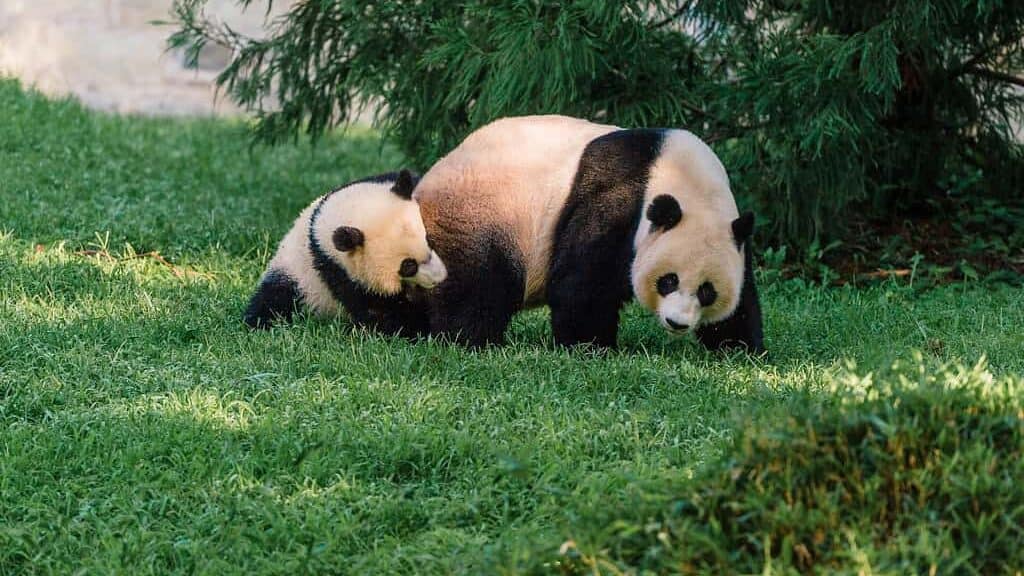The giant panda (Ailuropoda melanoleuca) is instantly recognizable worldwide thanks to its distinctive black and white fur pattern. This iconic mammal, native to central China, has captivated scientists and animal lovers alike with its unique appearance. The stark contrast between the panda’s black eye patches, ears, shoulders, and legs against its white body creates one of nature’s most memorable and beloved animal designs. While this coloration pattern may seem random or merely aesthetic, researchers have discovered that the panda’s striking appearance serves critical evolutionary functions.
Unlike many other animals whose coloration evolved primarily for one purpose, such as camouflage or mate attraction, the panda’s black and white pattern appears to serve multiple adaptive functions simultaneously. This multifunctional aspect makes the panda’s coloration particularly fascinating from an evolutionary biology perspective. The scientific investigation into why pandas look the way they do offers fascinating insights into how animal appearances evolve in response to complex environmental challenges and survival needs.
Evolutionary History of Pandas

To understand the panda’s unique coloration, we must first explore its evolutionary history. Giant pandas diverged from other bears approximately 19 million years ago, with the earliest panda-like fossils dating back about 8 million years. Despite being classified in the bear family (Ursidae), pandas evolved distinct characteristics, including their specialized bamboo diet and distinctive coloration pattern. This evolutionary journey took place primarily in the mountainous regions of central China, where their current range remains.
The ancestral bears from which pandas evolved were likely uniformly colored, similar to modern brown and black bears. The development of the panda’s black and white pattern represents a significant evolutionary adaptation that occurred as pandas specialized to their unique ecological niche. Understanding when and why this pattern emerged provides valuable insights into how natural selection shapes animal appearances in response to specific environmental challenges and lifestyle adaptations.
Camouflage in Snowy Environments

One of the leading scientific theories explaining the panda’s white portions involves camouflage in snowy environments. Pandas inhabit mountainous regions of central China where snowfall is common during winter months. The white fur on a panda’s body helps it blend into snowy landscapes, providing crucial concealment from potential predators. This adaptation would have been particularly important during the panda’s evolutionary history when they faced more natural predators than they do today.
Research published in Behavioral Ecology by Tim Caro and colleagues suggests that the white components of the panda’s pelage (fur) evolved specifically for snow camouflage. When observed against snowy backgrounds, the panda’s white fur creates an effective disruptive coloration that breaks up its outline, making it less visible to predators. This adaptation demonstrates how natural selection can favor specific color patterns that enhance survival in particular environments, even when the animal is relatively large.
The Dark Fur Advantage in Shaded Forests

While the white portions of a panda’s fur help with camouflage in snowy conditions, the black markings serve a different but equally important purpose. Scientists believe the dark patches help pandas blend into the shadowy forest environments where they spend significant time foraging for bamboo. The dense forests of central China create a mosaic of light and shadow, and the panda’s black portions help it disappear into shaded areas and dense vegetation.
This dual-purpose camouflage strategy is relatively rare in the animal kingdom, with most species evolving coloration suited primarily to one type of environment. The panda’s ability to blend into both snowy open areas and shadowy forests represents a sophisticated evolutionary compromise that reflects the complex habitat these animals navigate. By maintaining effective camouflage across different environmental contexts, pandas could historically reduce predation risk while moving between various parts of their habitat.
Communication Through Facial Markings

The distinctive black eye patches that make pandas so endearing to humans may serve important social functions among pandas themselves. Research suggests these facial markings may play a role in individual recognition and intraspecies communication. The high-contrast facial pattern creates a memorable and easily distinguishable face that could help pandas identify specific individuals, which is particularly important during breeding season or when establishing territorial boundaries.
Additionally, some scientists theorize that the dark eye patches may serve to intimidate potential competitors or predators by making the panda’s eyes appear larger and more threatening. This form of warning coloration, similar to that seen in other species like some butterflies with eye-spot patterns, could help pandas avoid dangerous confrontations. The specific shape and size of these markings may also signal information about an individual panda’s health, age, or status, though more research is needed to fully understand the communicative function of these distinctive facial features.
Temperature Regulation Hypothesis

Another fascinating scientific theory about panda coloration involves thermoregulation—the ability to maintain optimal body temperature. Some researchers suggest that the contrasting black and white pattern may help pandas regulate their body temperature more effectively. Dark colors absorb more heat from sunlight, while light colors reflect it. This difference could potentially allow pandas to manage their body temperature by positioning themselves strategically in their environment.
For example, during colder periods, a panda could expose its black fur patches to the sun to absorb more heat, while in warmer conditions, it could present more of its white fur to reflect heat. Although this hypothesis remains under investigation, it represents an intriguing possibility that the panda’s coloration serves not only visual functions but physiological ones as well. Similar temperature-regulating coloration has been observed in other species, suggesting this could be a viable explanation for part of the panda’s color pattern.
The Mystery of the Black Shoulders

One of the most puzzling aspects of panda coloration is their black shoulders and legs. Unlike the eye patches and ears, which may serve communication functions, or the white body for snow camouflage, the dark shoulders have been more difficult for scientists to explain. A groundbreaking study published in 2017 by researchers at the University of California, Davis and the California State University, Long Beach proposed that the dark shoulders might serve an aggressive signaling function, warning potential competitors about the panda’s strength.
The black shoulders effectively emphasize the powerful forelimbs that pandas use for climbing and processing bamboo. By highlighting these areas, pandas may be communicating their physical prowess to rivals. This form of natural signaling could help pandas avoid physical confrontations by establishing visual dominance. The study compared panda coloration to that of other carnivores and found surprising similarities in how dark markings are used to emphasize anatomical features related to aggression or strength, suggesting convergent evolution despite the panda’s herbivorous diet.
Scientific Research Methods

Understanding the evolutionary reasons behind panda coloration has required innovative research approaches. Scientists have utilized comparative analysis, examining the coloration patterns of pandas alongside other carnivores and bears to identify similarities and differences that might reveal evolutionary pressures. Researchers have also employed sophisticated computer modeling to analyze how panda coloration would appear to various predators and conspecifics under different lighting conditions and in various environments.
Field studies observing pandas in their natural habitat provide critical data about how their coloration functions in real-world conditions. Additionally, genetic studies have begun to uncover the molecular mechanisms that produce the panda’s distinctive coloration pattern. These multidisciplinary approaches combine to create a more comprehensive understanding of the evolutionary forces that shaped the panda’s unique appearance. By integrating findings from ecology, genetics, comparative biology, and behavioral studies, scientists continue to refine their theories about panda coloration.
Genetic Basis of Panda Coloration

The genetic underpinnings of the panda’s black and white pattern represent an area of ongoing scientific investigation. Research suggests that the panda’s coloration is controlled by a relatively small number of genes that regulate melanin production in specific body regions. Melanin is the pigment responsible for dark coloration in mammals, and its presence or absence creates the panda’s distinctive pattern. Studies of panda genetics have identified several candidate genes that may be involved in creating this unique color distribution.
Interestingly, the sharp delineation between black and white areas in pandas is unusual among mammals, which more commonly show gradual transitions between colors. This distinct boundary suggests highly specific genetic regulation of pigment production in different body regions. Comparative genetic studies with other bear species provide valuable insights into how these color-controlling genes evolved and diverged in pandas. Understanding the genetic basis of panda coloration not only satisfies scientific curiosity but also contributes to broader knowledge about how complex traits evolve.
Comparison to Other Bears

The panda’s black and white pattern stands in stark contrast to most other bear species, which typically display uniform coloration ranging from black to brown to white (in the case of polar bears). This difference raises important evolutionary questions about why pandas developed such distinctive markings while their bear relatives did not. The answer likely lies in the panda’s unique ecological niche and lifestyle adaptations, particularly their specialized bamboo diet and the specific habitats they occupy.
While most bears are omnivorous and range across varied habitats, pandas specialize in bamboo consumption and inhabit specific mountainous forest regions with distinct ecological characteristics. This specialization may have created unique selection pressures on panda appearance. Additionally, other bears like the spectacled bear and sun bear do show facial markings, albeit less dramatic than the panda’s, suggesting that some degree of facial patterning may be ancestral in certain bear lineages. These comparative analyses help scientists understand the evolutionary divergence that produced the panda’s iconic appearance.
Conservation Implications

Understanding the science behind panda coloration has important conservation implications. The specialized nature of the panda’s adaptations, including its distinctive coloration, highlights how precisely these animals have evolved to fit their specific ecological niche. This specialization makes pandas particularly vulnerable to habitat changes and environmental disruptions. Conservation efforts must take into account the full range of environments that pandas need—from snowy open areas to dense shadowy forests—to ensure their coloration adaptations remain functional.
Additionally, the panda’s iconic appearance has made it one of the world’s most recognizable conservation symbols. Their distinctive black and white pattern has helped raise awareness and funding for wildlife conservation globally. The scientific understanding of panda coloration adds depth to this symbolism, transforming pandas from merely cute animals to fascinating examples of evolutionary adaptation. By highlighting the complex science behind panda appearance, conservationists can deepen public appreciation for these remarkable animals and strengthen support for their protection.
Conclusion: Nature’s Perfect Design

The panda’s distinctive black and white pattern represents a remarkable example of evolutionary adaptation, serving multiple functions simultaneously in ways that scientists are still working to fully understand. From camouflage in diverse environments to communication, temperature regulation, and possibly aggressive signaling, the panda’s coloration demonstrates how natural selection can produce complex adaptations that address multiple survival challenges. This multifunctionality makes the panda’s appearance particularly fascinating from an evolutionary biology perspective.
As research continues, scientists are likely to uncover additional nuances about how and why pandas evolved their iconic look. The ongoing investigation into panda coloration illuminates broader principles about how animal appearances evolve in response to ecological pressures. Beyond its scientific significance, the panda’s distinctive appearance continues to captivate human imagination and foster connections between people and wildlife conservation efforts worldwide.
The science behind the panda’s black and white fur reminds us that in nature, beauty often serves practical purposes—what appears decorative to human eyes typically represents sophisticated adaptations shaped by millions of years of evolution. By appreciating both the aesthetic appeal and the functional significance of the panda’s coloration, we gain a deeper understanding of these beloved animals and the natural world they inhabit.
As we continue to protect giant pandas and their habitat, the mystery of their distinctive appearance serves as a compelling reminder of the intricate relationship between an animal’s appearance and its survival in specific environmental contexts. The panda stands as nature’s perfect design—a living testament to evolutionary processes that created one of the animal kingdom’s most iconic and instantly recognizable species.
- 10 Ancient Australian Creatures That Defy Evolution - August 15, 2025
- The Science Behind the Panda’s Distinct Black and White Fur - August 15, 2025
- The Fascinating World of Bioluminescence in Animals - August 15, 2025

